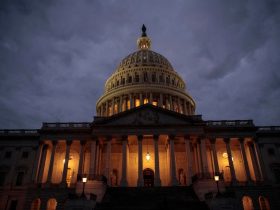Many Americans are living in financial distress, at least some of the time.
That’s the message of a recent Harris Poll, and it’s bad news for economic growth.
About 65% of working Americans say they frequently live paycheck to paycheck, according to a recent survey of 2,105 U.S. adults conducted by The Harris Poll, asking questions supplied by Barron’s. About 30% of households report that they run out of money at the end of every month, while 35% say they don’t have money left at the end of most months.
While the number of people living on the edge financially has an immediate effect on household well-being, there are also longer term economic costs, including higher debt levels and uneven retirement readiness. Those trends could also dampen overall economic growth.
Unsurprisingly, people earning less tend to struggle more, but even those considered well off are vulnerable to paycheck shocks. About 78% of Americans earning less than $50,000 a year report they live paycheck to paycheck, according to the survey. Yet 51% of Americans who make more than $100,000 a year say they still run out of money.
Living paycheck to paycheck is a fairly “ubiquitous” circumstance, says Fiona Greig, Vanguard’s global head of investor research and policy. That’s because U.S. adults generally tend to need a bigger cash buffer than they anticipate. Additionally, she says, many consumers are facing higher living expenses as inflation erodes their purchasing power.
The latest Harris survey data show a higher percentage of Americans living paycheck to paycheck than the roughly 60% reported in August in the Reality Check: Paycheck-To-Paycheck research series. The difference likely is due to differences in the survey population, and rising energy costs that hit consumers’ budgets in recent weeks. At the end of September, gasoline averaged $3.83 a gallon nationally, two cents more than in August, and seven cents more than a year earlier, according to AAA.
Data from the Reality Check series have oscillated since the Covid pandemic started. About 66% of those surveyed in March 2020 said they were spending down their paychecks. Some 52% of Americans were in such straits in April 2021, shortly after the most generous round of federal stimulus checks went out. The latest share, at 60%, is little-changed from the prior year.
Although generous government stimulus programs boosted consumers’ savings during the Covid pandemic, those outlays have waned. The Federal Bank of San Francisco estimated that Americans accumulated $2.1 trillion in total excess savings during the pandemic. Only about $190 billion remained on consumer balance sheets as of June, the bank estimated. Researchers anticipate the data will show that excess savings were gone completely as of the end of September.
Overall inflation also has taken a toll, leaving Americans with less purchasing power. Although headline inflation, as measured by the Consumer Price Index, has fallen from a high of 9% recorded in June 2022, prices climbed at a 3.7% annual pace in September, well above the Federal Reserve’s desired 2% target.
Even as Americans draw down their savings, they aren’t refilling their coffers. The U.S. personal savings rate—the percentage of disposable personal income to total income—was 3.9% in August, according to the Bureau of Economic Analysis. While that is 0.7 percentage points higher than a year ago during a higher-inflation period, the current rate is well below prepandemic averages.
Diminished savings suggest Americans are relying on more credit now than during the pandemic, and data bear that out. Total U.S. credit-card debt hit a record of $1.03 trillion during the second quarter, according to the Federal Reserve Bank of New York.
A slower rate of savings and a higher level of borrowing have longer term consequences for many Americans. Vanguard’s research indicates that even with the influx of cash during the pandemic, the vast majority of Americans aren’t on track to meet their spending needs in retirement, and that’s after including Social Security income and private savings. The problem is particularly acute for lower-income families.
Social Security benefits replace about 62% of the retirement income that families earning roughly $22,000 a year need once they no longer are working, Vanguard reported. Yet even higher-income Americans rely on Social Security. Families earning about $173,000 a year draw about 18% of their retirement income from Social Security, according to Vanguard.
Social Security is inflation-protected, but cost-of-living adjustments affect the amount of benefits paid, and as a result, impact the program’s projected long-term solvency. Social Security benefits are set to rise 3.2% for 2024, increasing the average monthly payment of $1,790 by $57.
The high percentage of financially vulnerable Americans, whether working or retired, poses broader problems. Consumer spending accounts for about 70% of the U.S. economy. If Americans pull back on their household spending because they need to pay interest on their credit cards or loans, or because they don’t have enough saved to live in retirement, that could impact the nation’s growth.
So far, most Americans have kept up with their debt payments while continuing to spend. Overall delinquencies were largely in check as of the second quarter.
The robust labor market has helped: The U.S. economy added 336,000 jobs in September, well above expectations. Even so, the imbalance between labor demand and supply continues to narrow, Fed Vice Chair Philip Jefferson said in a speech last Monday.
“We’re at kind of a turning point in our economy,” Greig says, noting that this could be an inflection point for consumers.
Write to Megan Leonhardt at megan.leonhardt@barrons.com
Read the full article here













Leave a Reply